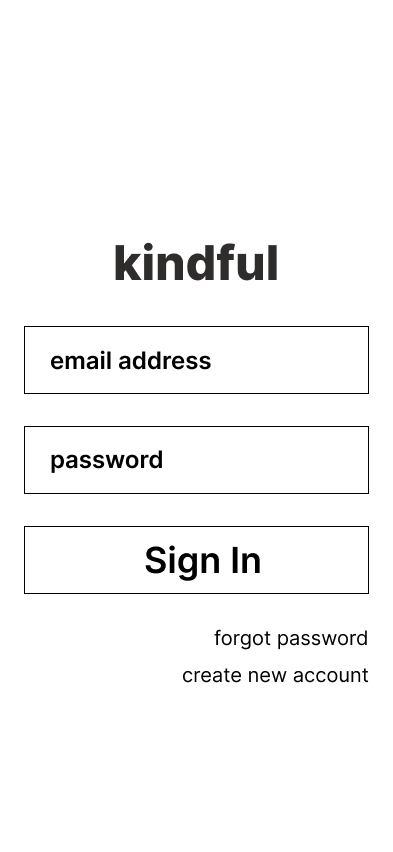Kindful
Kindful is an app designed to empower users to engage in acts of kindness within their communities.
UX Research | UI Design | Web Development

UX Case Study
〰️
UX Case Study 〰️
The Problem
We observed that people enjoy being kind for the sake of being kind and the way that it makes them feel. We also observed that people want to be more kind to others.
How might we increase opportunities that users have to be kind to others?
The Solution
Kindful is an app designed to empower individuals to effortlessly engage in acts of kindness by connecting them with nearby opportunities, inspiring a ripple effect of positivity in their communities.
Duration | 4 Wks
Tools | Miro, Figma, Github, VS Code, Google Suite, Trello
Discover
Brainstorming
Working with a group, we contemplated an app solution that helps increase mindfulness and positivity. This idea was sparked by a teammates conversation with their brother, who while having a crummy day noted that he wished that people were more self-aware and kinder to others.
Proto Persona
We initially proposed that our user would be someone who is stressed out and looking for an app that helps them destress and feel more positively about themself and others. This user changed as we dived deeper into our research.
Kindness by the Numbers
100% feel satisfied after doing something kind for others
80% rarely or never expect anything in return for their kind acts
20% only occasionally expect something in return
88.9% do not actively use the mindfulness apps they once used
We conducted 5 user interviews and collected 10 survey responses to determine users feelings around kindness and mindfulness. We found that by and large, users do kind things for others for the sake of being kind and because it makes them happy to do so. Additionally, we found that the current app solutions for cultivating kindness and mindfulness are not serving users effectively. Many mentioned using Calm, Headspace and Muse in the past, but not using these apps beyond the trial period.
At this point in our research, we knew we needed to pivot and differentiate our app with the top mindfulness and positivity apps on the market. We conducted a competitor analysis to determine what the other apps are doing right and what is causing their retention issues.
Key Takeaways from Research
Kindness is openness to help and do things for others
Users don't want to help people who aren't receptive
Streaks, rings, showing progress and rewarding keeps users engaged
Users leave most mindfulness apps after the trial period ends
Using insights from our survey responses and interviews, we developed an affinity diagram as a group. Above are our key takeaways from our affinity diagram.
Research Defined
User Insight
People WANT to be more kind.
Our user, who is concerned with people around her, needs a simple and consistent way to be kind to herself and others because she enjoys the feeling she gets from helping other people.
UX Hypothesis
Proximity is important.
People will be kind to members of their community as it is mutually beneficial. The theory of mutualism suggests that people will be kind, even to strangers if they are members of the same group.
Ideation
User Persona
To begin ideating, we revisit our user with greater insight. This user felt so different from our proto persona, so we renamed her, aged her up a bit, gave her a new look and adjusted her goals. She still doesn't like the existing positivity and mindfulness apps on the market but her motivation has since changed. She is looking for a solution to cultivate more kindness in her life, because it makes her happy to be kind to others.
Feature Prioritization Mapping
At this point in the process our app begun to take shape. Kindful will be an app that provided opportunities for users to engage with their community by completing and requesting acts of kindness. There would be a focus on gaining points and leveling up to encourage users to continue to engage with the app.
Storyboard
Prototyping and Development
Task Flows
Sign up for the Kindful app and view the tutorial onboarding screens
Complete an act of kindness for a neighbor
Request an act of kindness
Check weekly Kindful status on an Apple Watch
Sketching and Wireframing
Low Fidelity Usability Testing
Four usability tests were conducted and had the following success rates.
100% sign up for Kindful and view onboarding screens
62.5% complete an act of kindness for a neighbor
75% request an act of kindness
87.5% check weekly status on an Apple Watch
Key takeaways were renaming our “task” page to reflect the primary feature of our app, which is to facilitate acts of kindness. We also needed to further clarify the app concept by adding images and copy to more screens.
Style Guide
Refinement
High Fidelity Usability Testing
We iterated to high fidelity and then conducted another 4 usability tests.
100% sign up for Kindful and view onboarding screens
100% complete an act of kindness for a neighbor
100% request an act of kindness
100% check weekly status on an Apple Watch
A big improvement from the 1st round of testing, but there were still small edits we needed to make after testing like ensuring the iOS Home Indicator remained in view at the bottom of each screen.


Future Iterations
Test messaging component, so that communication between users could be regulated
Expand the rewards and badging for required points
Partner with local organizations and stores to offer discounts or coupons in exchange for acquired points
Build a community section that could have blog posts about how to do good locally and volunteering opportunities
Donation opportunities as rewards for acquired points








